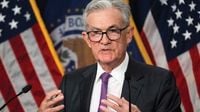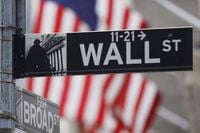On August 29, 2025, the U.S. Commerce Department released a set of economic data that painted a complex, even puzzling, picture of inflation, consumer spending, and the broader economy. The Federal Reserve’s preferred inflation gauge—the Personal Consumption Expenditures (PCE) price index—held mostly steady in July, despite the ongoing effects of President Donald Trump’s sweeping tariffs and persistent public pressure on central bank policy. Yet, beneath the surface, signs of underlying inflationary pressure and shifting consumer behavior are stirring debate among economists, policymakers, and market watchers alike.
According to the Commerce Department, prices rose 2.6% in July 2025 compared with a year earlier, matching June’s annual increase. But when food and energy—often volatile categories—are stripped out, the so-called core PCE price index climbed 2.9% year-over-year, up from 2.8% in June. That’s the fastest pace since February, as reported by Reuters and CNBC, and a clear signal that inflation remains stubbornly above the Federal Reserve’s 2% target.
On a month-to-month basis, consumer prices increased 0.2% from June to July, a slight slowdown from the previous month’s 0.3% rise. Core prices, however, ticked up 0.3% for the second month running, in line with consensus forecasts and further confirmation that price pressures are not abating as quickly as some policymakers—and certainly many consumers—might hope.
“The data supports a picture of the U.S. economy that is moving in a more stagflationary direction, albeit slowly,” Preston Caldwell, chief U.S. economist at Morningstar, told Reuters. “This presents somewhat of a quandary for the Fed, but we expect them to proceed with two rate cuts this year, given that expectations of rate cuts have been baked into the market for some time, and because of worrying data recently in the labor market.”
Indeed, the labor market appears to be losing steam. Employment gains averaged just 35,000 jobs per month over the last three months through July, sharply down from 123,000 during the same period a year earlier. This cooling trend has economists and central bankers alike watching closely for further signs of weakness, even as consumer spending remains robust.
Consumer spending, which accounts for more than two-thirds of U.S. economic activity, jumped 0.5% in July—the biggest monthly increase since March and a figure that matched economists’ expectations, according to the Bureau of Economic Analysis. Americans opened their wallets for long-lasting goods like cars, appliances, and furniture, with spending on durable goods up 1.9%. Outlays on recreational goods, clothing, and household equipment also rose, while spending on food and beverages ticked higher. However, spending at restaurants, bars, and hotels declined, suggesting that households are beginning to make more selective, budget-conscious choices amid lingering price pressures.
“A consumer that is cutting back on going out to eat and not booking as many hotel stays may not signal disaster, but it does point to the sort of budgeting decisions that households make when under pressure,” Tim Quinlan, a senior economist at Wells Fargo, told Reuters.
Personal income also rose 0.4% from June to July, buoyed by gains in wages and salaries. This uptick in income helped fuel the jump in spending, even as inflation continued to eat into purchasing power. The balance of price changes was notable: while energy prices declined 2.7% over the year and fell 1.1% in July alone, food prices rose 1.9% annually but dipped 0.1% on the month. Services prices, on the other hand, surged 3.6% year-over-year and 0.3% monthly, representing the bulk of the inflationary momentum as goods prices increased only 0.5% over the year and actually fell 0.1% in July.
Driving much of the services inflation was a 1.2% jump in the costs of financial services and insurance, a byproduct of a recent stock market rally. Housing inflation and recreation services also contributed to the uptick, while recreational goods and vehicles saw prices drop 0.9%.
Meanwhile, the U.S. goods trade deficit widened dramatically to $103.6 billion in July, a 22.1% surge from the previous month, according to the Census Bureau. Imports jumped 7.1%, likely reflecting businesses rushing to bring in goods ahead of further tariff increases, while exports dipped slightly by 0.1%. This ballooning trade gap could weigh on third-quarter GDP growth, with some economists estimating a drag of about three percentage points.
President Trump’s tariffs—first imposed in April 2025 with a baseline 10% duty on all imports, later expanded with reciprocal tariffs on multiple trading partners and the removal of exceptions for goods under $800—are widely seen as a key factor behind the inflation dynamics. While the immediate price effects have been muted, largely because businesses sold down inventories accumulated before the tariffs took effect and absorbed some costs, economists expect the full impact to emerge in the months ahead as inventories are depleted and higher operating costs are passed on to consumers.
Not surprisingly, inflation expectations among U.S. consumers are shifting. A University of Michigan survey found that one-year inflation expectations jumped to 4.8% in August from 4.5% in July, with a notable increase among voters identifying as Independents and Republicans. “We expect more unwelcome and tariff-induced price inflation to surface in the months ahead,” Scott Anderson, chief U.S. economist at BMO Capital Markets, told Reuters.
Against this backdrop, the Federal Reserve faces a delicate balancing act. Chair Jerome Powell has signaled that a rate cut is likely at the September 16-17 policy meeting, citing growing risks in the labor market but also acknowledging that inflation remains a persistent threat. Fed Governor Christopher Waller echoed this sentiment, saying he would consider a larger rate cut if labor market data continue to weaken. Markets are now pricing in an 87% chance of a quarter-point rate cut in September and 86% odds of at least 50 basis points in cuts by year’s end, according to CME Group’s FedWatch tool.
Yet, the Fed’s independence has come under renewed attack. President Trump has relentlessly pressured Powell and the Fed for lower interest rates, publicly criticizing the chair as “Too Late” and a “moron,” and arguing there is “no inflation.” On August 25, Trump sought to fire Fed board member Lisa Cook, citing accusations related to mortgage documents she signed before her tenure. Cook’s legal team has asked a federal court to block the firing, arguing that the charges are unrelated to her service at the Fed. If Trump succeeds, his appointees would hold a majority on the seven-member Board of Governors, potentially influencing the selection of regional Fed presidents and, by extension, central bank policy itself.
While Wall Street digested the data with a modest decline in the S&P 500—amid lingering concerns about China and corporate earnings—the U.S. dollar held steady and Treasury yields rose. For now, the U.S. economy remains on a knife’s edge, caught between persistent inflation, a cooling labor market, and the ever-present specter of political intervention in monetary policy. The coming weeks, and the Fed’s next move, will be watched with keen anticipation by all corners of the financial world.

